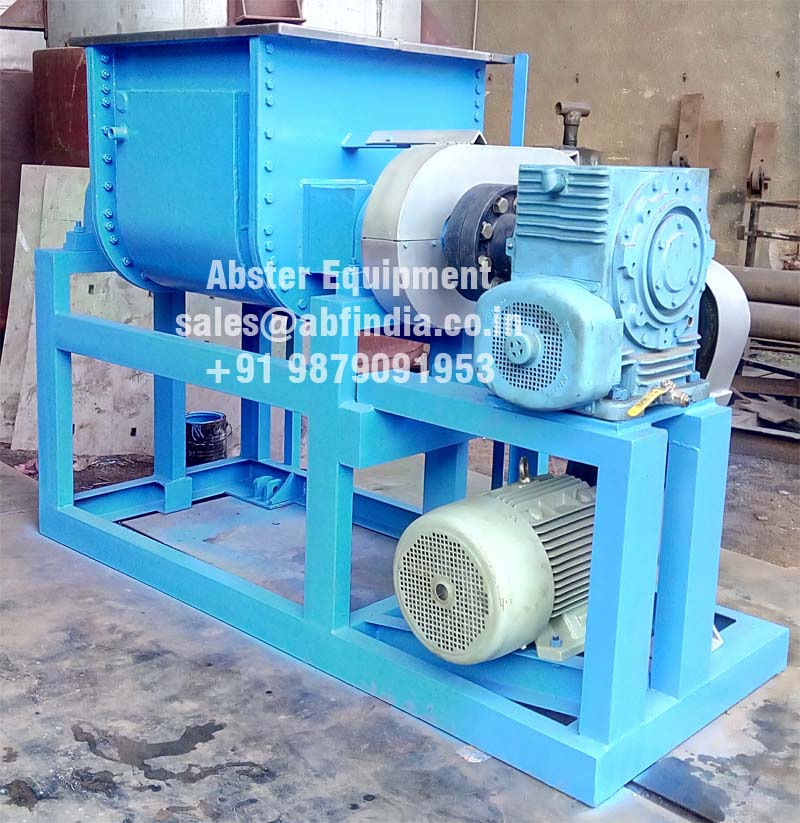
All double arm kneader mixers are equipped with two mixing blades placed in a W-shaped horizontal trough. Various blade profiles have evolved, each of which is best suited for a particular type of application. The commonly used blade types are the sigma blade, masticator blade, shredder blade, naben (aka fishtail) blade, and spiral blade. The rotation of the blades is either tangential to each other or the blades may overlap within the trough. The blades rotate toward each other at the same or differential speeds. The blades pass the container walls and each other at close clearances (2-3 mm) resulting in homogenous mixing. The close clearances produce very high shearing action thereby reducing any large particles. These mixers produce a consistent particle size distribution without the need for additional high speed choppers. Homogenous mixing is achieved within 10 to 30 minutes. Mixing homogeneity upto 99% and better can be achieved using the double arm kneader mixers. These mixers and their variants (double arm kneader mixer extruders) are capable of handling material with viscosities as high as 10 million centipoises. The power consumption in double arm kneader mixer is very high compared to other types of mixers and can range from 45 to 75 kW/m3 of mix material. The sigma blade mixer is the most commonly used type of double arm kneader mixer, and is best suited for all round use.
Sigma mixer is having wide range of industry wise applications. It is uses for production of highly viscous materials like Chemical, Dyes & Pigments, Paints, Polymers Plastic, Polyester Putties, Plastics, Pharmaceuticals, Food products etc. We are giving here below industry wise sigma mixer uses:
Food & Confectionery: Processing of finely milled wheat flour, bechamel sauce, chocolate, bubble gum, biscuit doughs, sugar paste, Bakery Dough, Chewing gum, Compounded Hing, Asafetida, Sugar pastes, Biscuit dough.
Paint & Solvents: Kneading of polyester putty, glass putty, adhesives, sealants, Fiberglass resin doughs, Polyester Compounds, Flush Colors, Brake lining compounds, Resins, Adhesives
Rubber Products: Mixing of rubber solution & silicon rubber, Stiff pastes, Silicon Rubbers, Viscous rubber solutions, Sealing compounds, Butyl rubber
FMCG: Blending of Liquid Soap, Liquid Detergent, Soap Noodles, Soap & Detergent, Ceramics,
Other Applications: Printing ink, Dispersion of iron compounds, ceramic powders, Crayon and pencil lead, Gaskets and gland packings, Grinding wheel preparations, Hot-Melts, Inks and pigment products, Marzipan,, Mastics, Metal powders, Moulding preparations, Pencil erasers, Pharmaceuticals, Plastics, Putties, Refractories, Magnetic Tape Coatings, Ceramics, Carbon Black, Carbon pastes, PVC coatings, Rubber Compounds, Fiber Glass, Grease, Lead Storage Battery, Zirconium Crucibles dough sigma mixer, Solid propellants
In Sigma mixer tangential action of mixing and kneading obtained by ‘Z’ type (SIGMA) shaped kneading blades, which rotates very accurately at different speed towards each other causing product to be transferred from one end to another end. Discharge of the finished product is achieved by tilting the container or through the valves at the bottom or by means of an extrusion screw beside the container.
The mixing action is a combination of bulk movement, stretching, folding, dividing, and recombining of the material. The shearing & tearing action of the material against blades and the side walls causes size reduction of the solids. After the time period required for sterilizing the batch has elapsed, the heating circuit shuts of the pneumatics damper (exhaust) opens and cooling operation commences.
In the tangential design, the blades rotate in the trough meeting tangentially. The front blade generally rotates faster than the rear blade usually in the ratio of 3:2. Tangential blades are generally used for material of higher viscosities such as adhesives, rubber compounds, flush colors, dyes, and pigments.
In the overlapping design, the blades overlap above the saddle of the container. Due to the overlapping action, it is necessary that the relative position of the two blades is unchanged, and as a result, both the blades rotate at the same speed. Materials that flow freely or creep down into the blades are mixed using the overlapping blade action. This design offers a faster interchange of material from one blade compartment of the mixer to the other. Overlapping blade action is used for materials of lighter viscosities such as carbon pastes, clay coating, creams, and ointments. The overlapping blade produces a lower kneading and shearing compared to the tangential blade action.
| Model | Capacity – Liters | Motor (H.P.) | ||
| Working Capacity approx. | Gross Capacity approx. | General | Heavy Duty | |
| ASM – 50 | 50 Liters | 80 Liters | 5 H.P. | 7.5 H.P. |
| ASM – 75 | 75 Liters | 110 Liters | 7.5 H.P. | 10 H.P. |
| ASM – 100 | 100 Liters | 150 Liters | 10 H.P. | 15 H.P. |
| ASM – 150 | 150 Liters | 200 Liters | 15 H.P. | 20 H.P. |
| ASM – 200 | 200 Liters | 300 Liters | 20 H.P. | 25 H.P. |
| ASM – 400 | 400 Liters | 550 Liters | 30 H.P. | 40 H.P. |
| ASM – 500 | 500 Liters | 750 Liters | 40 H.P. | 50 H.P. |
| ASM – 750 | 750 Liters | 1150 Liters | 50 H.P. | 60 H.P. |
| ASM – 1000 | 1000 Liters | 1500 Liters | 60 H.P. | 70 H.P. |
| ASM – 1500 | 1500 Liters | 2100 Liters | 75 H.P. | 80 H.P. |
| ASM – 2000 | 2000 Liters | 2600 Liters | 80 H.P. | 90 H.P. |
| ASM – 3000 | 3000 Liters | 3800 Liters | 100 H.P. | 120 H.P. |
* Power voltage can be adjusted as per customer’s domestic power voltage requirements.
* Rights of technical improvements & modification reserved.
* Illustrations & dimensions are shown for information purpose only.
Copyright © 2025, Abster™ Equipment All Rights Reserved.